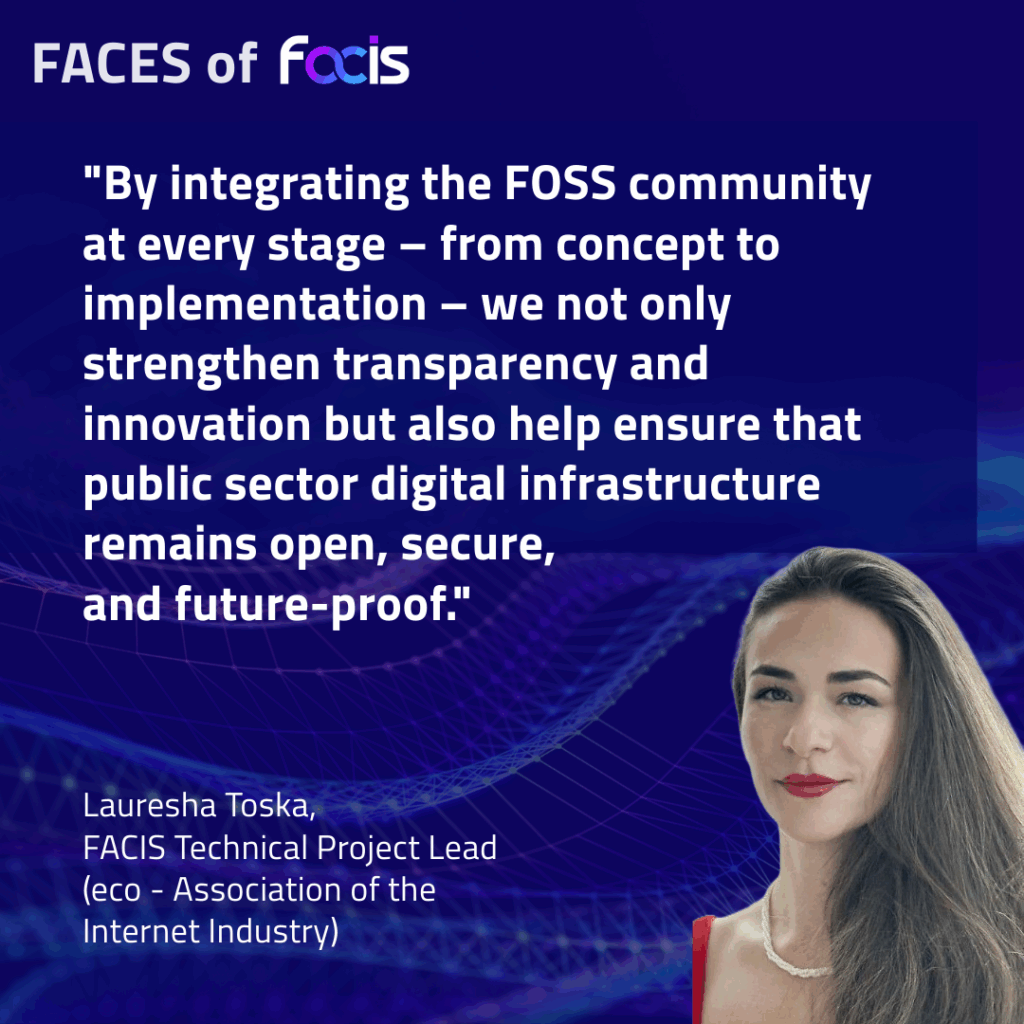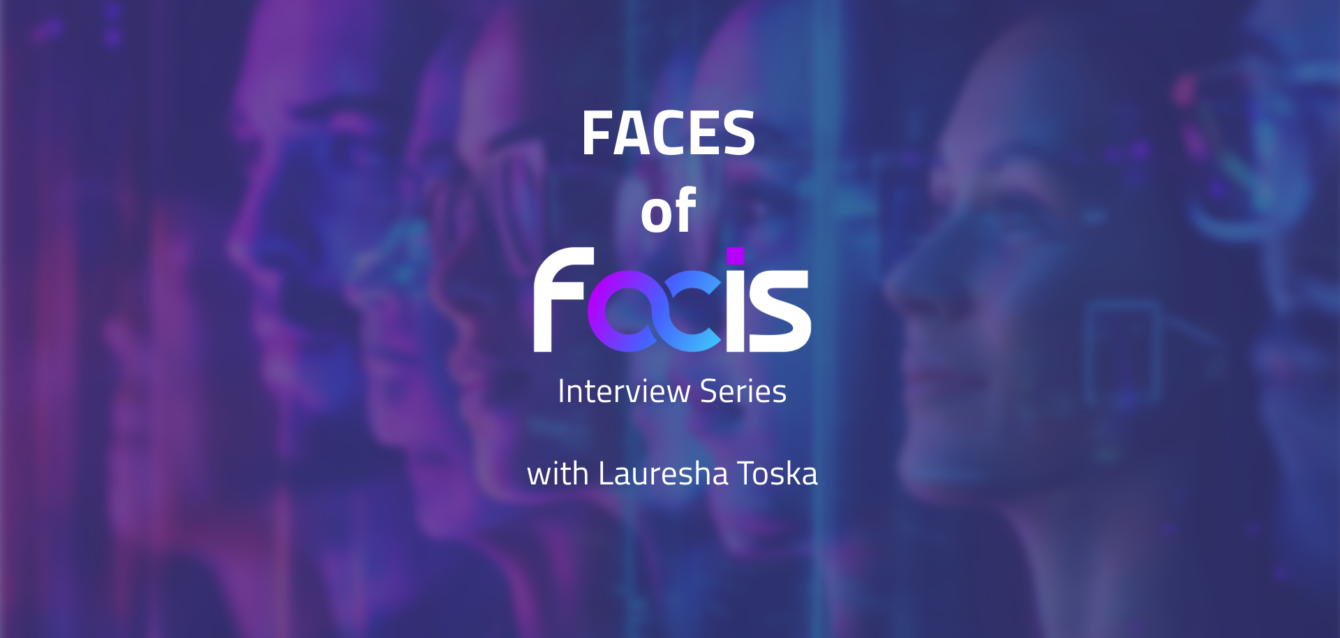Why integrating the community at every project stage plays a major role for valid results and how the technical deliverables will enforce real interoperability, Lauresha Toska, Technical Project Lead at FACIS, explains in the interview series FACES of FACIS.
Lauresha, you are the Technical Project Lead at FACIS. What innovative approach does the development of the technical solutions follow? Where do you see the biggest technical challenges in the project?
At FACIS, our technical solutions follow an open and modular approach. More precisely: All deliverables will be made accessible as open-source and via low-code orchestration platform – this makes the integration of FACIS’ solutions faster, more transparent, and scalable. So, upholding practical benefits, we’re developing standardized Federation Architecture Patterns and machine-readable SLAs to enable secure, trusted interoperability between diverse cloud and edge environments.
But in the end, achieving real interoperability is the biggest technical challenge in a fragmented digital ecosystem. Especially, when dealing with multiple providers, regulatory frameworks, and cross-border compliance. Balancing flexibility with robust governance and security is where much of the complexity lies.
Achieving real interoperability is the biggest technical challenge in a fragmented digital ecosystem.
The Digital Contracting Service will be designed to support EUDI where applicable. Could you explain why this connection with EUDI is significant and what motivated you to follow this approach?
First of all, the Digital Contracting Service, FACIS aims to develop, addresses the need to simplify and standardize digital contracting in a fragmented, multi-provider landscape.
Connecting the Digital Contracting Service with the European Digital Identity (EUDI) is significant because it brings a new level of trust, security, and legal recognition to digital agreements across Europe. By supporting EUDI, we ensure that identity verification and electronic signatures in digital contracts are fully compliant with EU regulations, such as the eIDAS framework. This is crucial for enabling seamless, cross-border transactions and securing that digital contracts are legally valid throughout the EU.
The benefits: automating identity checks and digital signatures, making the contracting process faster, more reliable, and universally accepted. Ultimately, this strengthens trust among all parties and supports FACIS’ goal of building a unified and interoperable European digital infrastructure. Federation Architecture Patterns (FAPs) as innovative design patterns to build federated ecosystems.

In the conceptual phase of the technical deliverables, how do you plan to engage with the 8ra community and other stakeholders?
We plan to engage all stakeholders proactively through a combination of structured collaboration and open dialogue – directly with the 8ra community as well as using our FACIS channels.
By actively participating in 8ra’s dedicated workstreams and platform discussions, we ensure our technical concepts are aligned with the broader ecosystem and benefit from the collective expertise of the community.
At FACIS, we complement this by organizing targeted workshops, roundtables, and online presentations to share our progress, gather feedback, and validate our approaches. We also regularly publish articles and updates to keep all stakeholders informed and encourage ongoing participation.
A combination of structured collaboration and open dialogue
This multi-faceted engagement strategy allows us to incorporate diverse perspectives early in the development process, foster transparency, and build strong partnerships. In this way, we procure that our deliverables are robust, relevant, and widely supported within the European cloud and edge community.
Given that the implementations will involve public tendering, how do you intend to engage the Free and Open-Source Software (FOSS) community throughout this process?
To ensure meaningful engagement with the Free and Open-Source Software (FOSS) community throughout the public tendering process, we plan to build on our existing collaborative approach with the 8ra community and stakeholders. This means:
- Early and Transparent Communication: We will share our technical concepts, requirements, and draft specifications with the FOSS community through open workshops, roundtables, and online presentations, inviting feedback before formal tender documents are finalized. Hereby, FOSS contributors and organizations can help – already at an early stage – to shape requirements and identify opportunities for collaboration.
- Inclusive Tender Specifications: In line with European guidelines, our tenders will be written to allow fair competition between open source and proprietary solutions, explicitly describing FOSS properties and evaluation criteria such as open standards, interoperability, and access to source code. This approach encourages participation from FOSS providers and avoids unnecessary barriers to entry.
- Community-Building Activities: We will continue to foster a vibrant ecosystem by publishing articles, sharing results, and supporting knowledge exchange between different actors. This helps to raise awareness, build trust, and guarantees that solutions developed are sustainable and replicable across different contexts.
- Ongoing Collaboration: After procurement, we will encourage continued involvement of the FOSS community in implementation, maintenance, and governance – achieving long-term sustainability and adaptability of the solutions.
By integrating the FOSS community at every stage – from concept to implementation – we not only strengthen transparency and innovation but also help ensure that public sector digital infrastructure remains open, secure, and future-proof.
Let’s take a look at one explicit key deliverable of the project: Federation Architecture Patterns (FAPs). FACIS stands for Federation Architecture for Composed Infrastructure Services. No wonder that the development of FAPs is a major aspect of the project. Can you explain what exactly is meant by this in more detail?
Federation Architecture Patterns (FAPs) in FACIS are standardized, reusable blueprints that outline how independently and securely cloud and edge providers can collaborate within a federated ecosystem. By implementing these patterns, federations can create scalable, interoperable, and trusted digital infrastructures, critical to advancing Europe’s sovereign and open digital ecosystem.
FAPs address essential components such as identity and access management, trust frameworks, orchestration, data sovereignty, and compliance. They define the technical, organizational, and governance frameworks necessary to facilitate cooperation, resource sharing, and integrated service delivery, while maintaining provider autonomy.
We plan validating (the solutions) through real-world Proof-of-Concept (PoC) projects
How do you ensure that the solutions developed provide genuine added value and remain widely accessible?
This is a very important question, which is why we plan validating them through real-world proof-of-concept (PoC) projects and by prioritizing ease of use. We are going to conduct PoCs where several independent cloud and edge providers implement Federation Architecture Patterns (FAPs) to securely exchange data and orchestrate services across organizational boundaries. These initiatives will demonstrate that – by following shared FAPs –, providers can collaborate efficiently without sacrificing autonomy or security.
Additionally, we use a low-code orchestration engine, which allows users with minimal technical expertise to adopt and customize our solutions. Instead of requiring advanced programming skills, users can configure and connect services through intuitive, drag-and-drop like interfaces, lowering the barrier to entry and enabling a wider range of organizations to benefit from advanced digital infrastructure.
By combining practical demonstrations with accessible technology, we make sure our solutions deliver real impact and are usable by as many stakeholders as possible.
